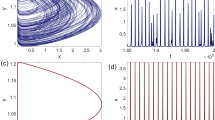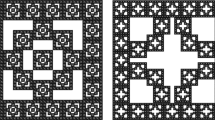Abstract
The Tile Assembly Model is a Turing universal model that Winfree introduced in order to study the nanoscale self-assembly of complex DNA crystals. Winfree exhibited a self-assembly that tiles the first quadrant of the Cartesian plane with specially labeled tiles appearing at exactly the positions of points in the Sierpinski triangle. More recently, Lathrop, Lutz, and Summers proved that the Sierpinski triangle cannot self-assemble in the “strict” sense in which tiles are not allowed to appear at positions outside the target structure. Here we investigate the strict self-assembly of sets that approximate the Sierpinski triangle. We show that every set that does strictly self-assemble disagrees with the Sierpinski triangle on a set with fractal dimension at least that of the Sierpinski triangle (≈1.585), and that no subset of the Sierpinski triangle with fractal dimension greater than 1 strictly self-assembles. We show that our bounds are tight, even when restricted to supersets of the Sierpinski triangle, by presenting a strict self-assembly that adds communication fibers to the fractal structure without disturbing it. To verify this strict self-assembly we develop a generalization of the local determinism method of Soloveichik and Winfree.
Similar content being viewed by others
References
Barlow, M.T., Taylor, S.J.: Defining fractal subsets of ℤd. In: Proc. London Math. Soc., vol. 64, pp. 125–152 (1992)
Bondarenko, B.A.: Generalized Pascal Triangles and Pyramids, Their Fractals, Graphs and Applications. The Fibonacci Association (1993)
Cahen, E.: Sur la fonction ζ(s) de Riemann et sur des fonctions analogues. Annales Scientifiques de L’École Normale Supérieure 11(3), 75–164 (1894)
Doty, D., Gu, X., Lutz, J.H., Mayordomo, E., Moser, P.: Zeta-dimension. In: Proc. of the Thirtieth International Symposium on Mathematical Foundations of Computer Science. Lecture Notes in Computer Science, vol. 3618, pp. 283–294. Springer, Berlin (2005)
Euler, L.: Variae observationes circa series infinitas. Comment. Acad. Sci. Imp. Petropolitanae 9, 160–188 (1737)
Graham, R.L., Knuth, D.E., Patashnik, O.: Concrete Mathematics. Addison-Wesley, Reading (1994)
Hueter, I., Peres, Y.: Self-affine carpets on the square lattice. Comb. Probab. Comput. 6, 197–204 (1997)
Kautz, S.M., Lathrop, J.I.: Self-assembly of the Sierpinski carpet and related fractals. In: Proc. of the Fifteenth International Meeting on DNA Computing and Molecular Programming. Lecture Notes in Computer Science, vol. 5877, pp. 78–87. Springer, Berlin (2009)
Lathrop, J.I., Lutz, J.H., Summers, S.M.: Strict self-assembly of discrete Sierpinski triangles. Theor. Comput. Sci. 410, 384–405 (2009)
Olsen, L.: Distribution of digits in integers: fractal dimension and zeta functions. Acta Arith. 105(3), 253–277 (2002)
Patitz, M.J.: Simulation of self-assembly in the abstract tile assembly model with ISU TAS. In: Proc. of the Sixth Annual Conference on Foundations of Nanoscience: Self-Assembled Architectures and Devices (2009)
Patitz, M.J., Summers, S.M.: Self-assembly of discrete self-similar fractals. Nat. Comput. 9(1), 135–172 (2010)
Roco, M.C., Mirkin, C.A., Hersam, M.C.: Nanotechnology research directions for societal needs in 2020, NSF/WTEC report. Springer, Berlin (2011)
Rothemund, P.W.: Theory and experiments in algorithmic self-assembly. Ph.D. thesis, University of Southern California, Los Angeles, California (2001)
Rothemund, P.W.K., Papadakis, N., Winfree, E.: Algorithmic self-assembly of DNA Sierpinski triangles. PLoS Biol. 2(12) (2004)
Rothemund, P.W.K., Winfree, E.: The program-size complexity of self-assembled squares. In: Proc. of the Thirty Second Annual ACM Symposium on Theory of Computing (2000)
Seeman, N.C.: Nucleic-acid junctions and lattices. J. Theor. Biol. 99, 237–247 (1982)
Seeman, N.C.: DNA in a material world. Nature 421, 427–431 (2003)
Sierpiński, W.: Sur une courbe dont tout point est un point de ramification. C. R. Math. 160, 302–305 (1915)
Soloveichik, D., Winfree, E.: Complexity of self-assembled shapes. SIAM J. Comput. 36, 1544–1569 (2007)
Stewart, I.: Four encounters with Sierpinski’s gasket. Math. Intell. 17(1), 52–64 (1995)
Wang, H.: Proving theorems by pattern recognition, ii. Bell Syst. Tech. J. 40, 1–41 (1961)
Wang, H.: Dominoes and the AEA case of the decision problem. In: Proc. of the Symposium on Mathematical Theory of Automata (1962)
Willson, S.J.: The equality of fractional dimensions for certain cellular automata. Physica D 24, 179–189 (1987)
Winfree, E.: Algorithmic self-assembly of DNA. Ph.D. thesis, California Institute of Technology, Pasadena, California (1998)
Author information
Authors and Affiliations
Corresponding author
Rights and permissions
About this article
Cite this article
Lutz, J.H., Shutters, B. Approximate Self-Assembly of the Sierpinski Triangle. Theory Comput Syst 51, 372–400 (2012). https://doi.org/10.1007/s00224-011-9345-4
Published:
Issue Date:
DOI: https://doi.org/10.1007/s00224-011-9345-4




